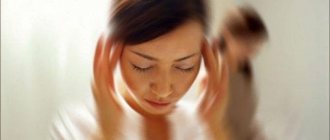Photophobia symptoms
Photophobia can manifest itself in the following signals:
- squinting eyelids even in conditions of
In this article
Photophobia symptoms
- Causes
- Photophobia as a symptom
- Diagnosis and treatment of photophobia
dim lighting;
Photophobia is often accompanied by headache and dizziness, the effect of sand in the eyes, and a gradual deterioration in visual function. The presence of photophobia can be determined independently by these symptoms, but you should consult a doctor for an accurate diagnosis and prescription of corrective therapy.
Causes of photophobia of the eyes
The origin of photophobia can be of different nature:
- Physiological - photophobia resulting from prolonged exposure to darkness and twilight, too bright lighting, excessive UV irradiation, excessively long daily reading, working at a monitor or studying books; in addition, albinism and light eye colors as a result of translucent iris .
- Pathological - as a consequence of various burns, injuries, eye diseases, or is a symptom of chronic fatigue syndrome , dry eyes , depression , neurasthenia , headache , stroke , abscess and brain tumors , as well as intoxications , pityriasis rosea , rubella , , rabies , influenza , meningitis , epilepsy , manifestations of trigeminal neuralgia , blepharospasm , cataracts, glaucoma , Parkinson's syndrome , adenoviral or allergic conjunctivitis , keratoconus , retinal detachment and keratitis .
- Pharmacological - when using anticholinergic drugs that dilate the pupils, for example, Atropine , Ipratropium , Pirenzepine , as well as sedatives such as barbiturates, benzodiazepines, Haloperidol , the antiepileptic drug Ethosuximide , antidepressants, etc.
A number of factors and changes in the nervous system contribute to the development of excessive sensitivity to light. These include:
- increased sensitivity to loud sounds;
- depletion of nervous system mediators;
- lack of sleep;
- irritability;
- excessive emotional stress and stress;
- chronic fatigue;
- power errors.
Causes of photophobia in children
The state of hypersensitivity to the effects of light rays on the eyes may be transient and functional, or may be associated with other organic pathological processes. It is important to know what diseases photophobia can occur as a manifestation or complication of the disease and contact a pediatrician as soon as possible for their diagnosis and treatment!
Causes
- Photophobia can occur for non-pathological reasons:
- a congenital structural feature of the eye with the absence of coloring pigment;
- dilated pupils when using eye drops;
- use of certain medications;
- prolonged work at the computer, which overloads the eyesight and causes dry mucous membranes;
- prolonged stay in the dark;
- the presence of a foreign body in the organs of vision (in this case, photophobia usually affects one eye and is accompanied by cutting sensations);
- exposure to excess sunlight on the retina.
For such reasons, fear of bright light does not indicate the presence of a disease.
But in some cases, photophobia is a sign of the disease, which, in combination with other signs, indicates the true cause of the pathology:
- the presence of an ophthalmological disease (keratitis, conjunctivitis, etc.);
- acute infectious diseases (measles, rubella, meningitis);
- cold viral infections;
- in rare cases - neurological disorders, depressive disorders, chronic fatigue.
Getting rid of photophobia in such situations can only be done by identifying and treating the underlying disease.
Photophobia in children
Most often, fear of light becomes an acquired disorder, but there are cases when it is congenital and is observed in children from an early age. For example, the reason for this may be albinism, color blindness, etc.
Photophobia in a child is a rather dangerous condition and can lead to the fact that it will be painful for him to look at the light, so parents need to ensure that their children have less stress, injuries, risk of infection, normalized use of electronic devices, optical instruments, compliance with hygiene standards, if necessary, correct vision correction, eye gymnastics.
Photophobia as a symptom
By analyzing the compatibility of symptoms, you can guess what pathology caused the appearance of photophobia, but only a doctor can make an accurate diagnosis.
- Photophobia and lacrimation
Their simultaneous appearance may indicate a mechanical injury, a foreign body or substance entering the eye; inflammation or erosion of the cornea; conjunctivitis; influenza or acute respiratory disease; aniridia and other developmental anomalies of the eyeball; inflammation, melanoma or retinal detachment; retinopathy; hemophthalmos; hyperthyroidism; uveitis; migraine; encephalitis, meningitis.
In addition to lacrimation and photophobia, each of these diseases is characterized by a whole list of other symptoms that help the doctor make an accurate diagnosis and prescribe competent treatment.
- Photophobia and eye pain
They can be combined with burns, ulcers, mechanical damage to the cornea, spring catarrh, acute glaucoma, endophthalmitis.
- Photophobia and redness of the eyes
The simultaneous appearance of these signs may indicate injury or burn of the cornea, keratitis, uveitis, conjunctivitis.
- Sun sensitivity and fever
Increased sensitivity to light in combination with a rise in body temperature may indicate meningitis, endophthalmitis, encephalitis, trigeminal neuralgia, hemorrhagic stroke, brain abscess, purulent uveitis.
- Photophobia and headache
This combination is typical for brain abscess, migraine, encephalitis and meningitis, stroke, tension headaches, acute attacks of glaucoma, acromegaly.
- Fear of light and nausea
Typically, nausea combined with photophobia indicates increased pressure inside the eyes or skull, which is typical for diseases such as meningitis, migraines, hemorrhagic stroke, and brain abscess.
- Photophobia and pain in the eyes
Cutting sensations in the eyes with fear of bright light are characteristic of conjunctivitis, keratitis, astigmatism, trigeminal neuralgia, uveitis, blepharitis, ulcers and burns of the cornea.
What is photophobia?
Squinting from the bright sun or closing your eyes for a few seconds when leaving a dark room to go outside is a normal reaction of the body. As a rule, a few minutes are enough to adapt to different lighting. But people suffering from photophobia do not get used to bright light even after some time. Discomfort can be caused not only by the sun, but also by light from fluorescent and other lamps, as well as normal lighting, in which the eyes of a healthy person feel comfortable.
Sensitivity to light can be chronic, or it can be temporary, associated with some event, such as injury.
Contrary to the opinion of many patients, photophobia is not an eye disease as such, but a signal that a person has an eye pathology or a disease of the nervous system.
The following symptoms may often occur along with photophobia:
- Cutting, burning, pain or other discomfort in the eyes.
- Tearing.
- Desire to squint even in dim light.
- Increase in pupil diameter.
- Redness of the eyes.
- Decreased visual acuity.
- Dry eye syndrome.
- Tired eyes.
- Flashes, flies, floating dots, blurred vision.
Fear of light can also be accompanied by other symptoms (they depend on the disease that provoked photophobia). Among them:
- headache, migraine, dizziness;
- shortness of breath;
- nausea;
- pressing chest pain;
- sudden changes in mood, irritability, depression, aggressive behavior.
Regardless of the number of symptoms, we recommend consulting a doctor. Only a specialist can make the correct diagnosis, find the cause of photophobia and prescribe the correct treatment for the disease that provoked it.
Diagnosis and treatment of photophobia
Therapy for photophobia is based on finding and eliminating the cause of this symptom. The following types of studies help to detect a disease that has manifested itself as photophobia:
- ophthalmoscopy - when performed, the doctor examines the fundus of the eye using a special device;
- biomicroscopy - an ophthalmologist examines areas of the fundus and the vitreous body through a slit lamp for changes;
- perimetry - this method allows you to establish the boundaries of the patient’s field of vision;
- tonometry - a test during which the doctor measures the pressure inside the eyes;
- gonioscopy - involves examining the corner of the eye where the iris borders the cornea;
- pachymetry is a diagnostic test in which the doctor determines the thickness of the cornea;
- Ultrasound of the organs of vision - helps to examine areas of the eye when ophthalmoscopy is not possible;
- fluorescein angiography - during this, the doctor examines the patency of the vessels that feed the ocular structures;
- optical tomography - it is used to detect changes in the tissues of the retina;
- electroretinography is a research method aimed at analyzing the functioning of the retina;
- culture for viruses, bacteria - helps to establish the source of the eye infection.
These diagnostic methods allow the ophthalmologist to name the exact cause of the development of photophobia and other associated symptoms. If ophthalmological examinations show the absence of eye diseases, but photophobia is present, consultation with a neurologist is required. This specialist may prescribe additional diagnostic tests: MRI of the brain, Dopplerography of the cervical vessels, electroencephalography.
If, along with photophobia, signs of hyperfunction of the thyroid gland or diabetic retinopathy were detected, an endocrinologist is involved in treatment. For symptoms indicating a tuberculosis process in the cornea, call a phthisiatrician.
Consultation with an ophthalmologist in case of photophobia is mandatory, but prophylactic wearing of sunglasses, which will significantly reduce the dose of ultraviolet radiation affecting the organs of vision, will help ease its course.
Photophobia
Photophobia (scientific name photophobia) is a pathological reaction to light. When we come out of the darkness into the light or find ourselves under too much bright light, we usually squint, protecting our eyes until they adapt to the new conditions. This is a normal reaction. If adaptation to the lighting regime does not occur, and not only too bright light is inconvenient, but also normal lighting, then photophobia is evident. The light makes you want to close your eyes and cover yourself with your hand. Exposure to light can cause pain in the eyes and increased lacrimation.
Causes
Hypersensitivity to light is not an independent disease; as a rule, it accompanies the following pathologies and conditions that require immediate attention to an ophthalmologist:
- Inflammatory processes of the eyes (conjunctivitis, keratitis, uveitis).
- Eye damage (injuries, burns, corneal erosions).
- In addition, photophobia may be one of the signs of wearing incorrectly fitted contact lenses.
Other reasons for high eye sensitivity to light include:
- Light color of the iris (in this case, the choroid does not contain enough pigment to protect the retina from the damaging effects of bright light).
- Hereditary diseases (absolute color blindness, albinism).
- Diseases of the nervous system (migraine, meningitis).
- Infectious diseases (measles, rubella).
- Intoxication of the body (poisoning with chemicals, including drugs: belladonna, quinine, tetracycline, furosemide, doxycycline).
Photophobia of the eyes in an adult: why it occurs
One of the most common causes of photophobia are various infectious, inflammatory and other diseases of the visual organs. Often people suffering from conjunctivitis (inflammation of the uvea), keratitis (inflammation of the cornea), and iritis (inflammation of the iris) turn to ophthalmologists with this problem.
In some cases, photophobia of the eyes in adults manifests itself due to adverse environmental influences, for example, with prolonged exposure to ultraviolet rays reflected from snow. Also, photophobia can result from damage to the eyes from excessively bright light during welding work without protective glasses. Sometimes the occurrence of this reaction is associated with some common diseases, such as migraine, acute respiratory infections, influenza, and an acute attack of glaucoma may also be the cause.
People on forums often ask what serious disease symptom is photophobia. Experts say that this reaction may indicate problems with the thyroid gland or signal a tumor in the brain. The patient will be prescribed additional examinations, such as ultrasound, MRI or CT. The causes of photophobia are sometimes associated with damage to the visual organs of various types, including wearing incorrectly selected contact lenses or penetration of a foreign body. Sunburn, as well as ulcers, erosion and mechanical damage to the cornea can also cause involuntary squinting of the eyes when in direct contact with a light source.
What diseases does increased light sensitivity of the eyes indicate? The appearance of this reaction is often not associated with pathological processes. Sometimes constant drying of the cornea and increased visual stress also become the causes of photophobia. This is especially true for people who spend a long time in front of a computer monitor.
In rare cases, symptoms of photophobia occur in people due to the complete absence or insufficient amount of a special pigment in the body (melanin). At the same time, the eyes react too actively to any light source. In this case, the pathology is congenital. It should be noted that this form of sphetophobia is quite rare.
Photophobia can be a symptom of what disease?
- Various diseases of the organs of vision (inflammatory, infectious, etc.);
- Malfunctions of the nervous system;
- Pathologies of the functioning of the thyroid gland;
- General diseases (flu, acute respiratory infections, glaucoma);
- Hereditary diseases associated with insufficient melanin in the body.










